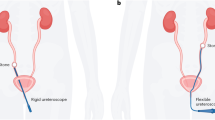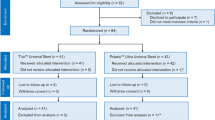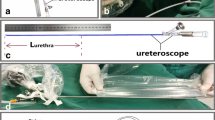Abstract
Study design:
Retrospective study.
Objectives:
The purpose of this investigation was to review the outcomes and safety of retrograde ureteroscopic laser lithotripsy (URS) for the treatment of urolithiasis in the spinal cord injury (SCI) population.
Setting:
Virginia, USA.
Methods:
All patients with SCI who underwent URS with holmium:YAG laser lithotripsy for urolithiasis over a 15-year period were identified. Stone size, location and number at presentation were recorded. Information regarding patient characteristics, intra-operative complications, surgical efficacy, stone clearance, peri-operative complications, and follow-up stone events was collected and analyzed.
Results:
A total of 67 URS procedures were performed on 29 SCI patients during the study period with an average follow-up of 3.4 years. Patients had an average of 2.3 ipsilateral ureteroscopies. The majority (85.1%) used indwelling catheters for long-term bladder management, and complete stone clearance after the first procedure was 34.3%. Of the 44 cases with residual stones >4 mm, 20 (45.5%) were secondary to technical or procedural limitations. The intra-operative complication rate was comparable to non-SCI studies at 1.5%, but peri-operative complications were significantly higher at 29.9% with the majority due to urosepsis. Factors associated with peri-operative complications include chronic obstructive pulmonary disease, motor incomplete injuries and lack of a pre-operative ureteral stent.
Conclusion:
URS in the SCI population is an effective treatment for ureteral or renal stones but may be associated with greater risks and reduced efficacy.
Sponsorship:
None.
Similar content being viewed by others
Log in or create a free account to read this content
Gain free access to this article, as well as selected content from this journal and more on nature.com
or
References
Chen Y, DeVivo MJ, Roseman JM . Current trend and risk factors for kidney stones in persons with spinal cord injury: a longitudinal study. Spinal Cord 2000; 38: 346–353.
Fabrizio MD, Behari A, Bagley DH . Ureteroscopic management of intrarenal calculi. J Urol 1998; 159: 1139–1143.
Grasso M . Ureteropyeloscopic treatment of ureteral and intrarenal calculi. Urol Clin North Am 2000; 27: 623–631.
Jiang H, Wu Z, Ding Q, Zhang Y . Ureteroscopic treatment of ureteral calculi with holmium:YAG laser lithotripsy. J Endourol 2007; 21: 151–154.
Sofer M, Watterson JD, Wollin TA, Nott L, Razvi H, Denstedt JD . Holmium:YAG laser lithotripsy for upper urinary tract calculi in 598 patients. J Urol 2002; 167: 31–34.
Preminger GM, Tiselius HG, Assimos DG, Alken P, Buck C, Gallucci M et al2007 Guideline for the management of ureteral calculi. J Urol 2007; 178: 2418–2434.
Klausner AP, Steers WD . The neurogenic bladder: an update with management strategies for primary care physicians. Med Clin North Am 2011; 95: 111–120.
Garcia-Nieto V, Siverio B, Monge M, Toledo C, Molini N . Urinary calcium excretion in children with vesicoureteral reflux. Nephrol Dial Transplant 2003; 18: 507–511.
Niedrach WL, Davis RS, Tonetti FW, Cockett AT . Extracorporeal shock-wave lithotripsy in patients with spinal cord dysfunction. Urology 1991; 38: 152–156.
Deliveliotis C, Picramenos D, Kostakopoulos A, Stavropoulos NI, Alexopoulou K, Karagiotis E . Extracorporeal shock wave lithotripsy in paraplegic and quadriplegic patients. Int Urol Nephrol 1994; 26: 151–154.
Lazare JN, Saltzman B, Sotolongo J . Extracorporeal shock wave lithotripsy treatment of spinal cord injury patients. J Urol 1988; 140: 266–269.
Culkin DJ, Wheeler JS, Nemchausky BA, Fruin RC, Canning JR . Percutaneous nephrolithotomy in the spinal cord injury population. J Urol 1986; 136: 1181–1183.
Lawrentschuk N, Pan D, Grills R, Rogerson J, Angus D, Webb DR et al Outcome from percutaneous nephrolithotomy in patients with spinal cord injury, using a single-stage dilator for access. BJU Int 2005; 96: 379–384.
Comperat E, Reitz A, Delcourt A, Capron F, Denys P, Chartier-Kastler E . Histologic features in the urinary bladder wall affected from neurogenic overactivity--a comparison of inflammation, oedema and fibrosis with and without injection of botulinum toxin type A. Eur Urol 2006; 50: 1058–1064.
Ramsey S, McIlhenny C . Evidence-based management of upper tract urolithiasis in the spinal cord-injured patient. Spinal Cord 2011; 49: 948–954.
Schoenfeld AJ, Ochoa LM, Bader JO, Belmont PJ . Risk factors for immediate postoperative complications and mortality following spine surgery: a study of 3475 patients from the national surgical quality improvement program. J Bone Joint Surg Am 2011; 93: 1577–1582.
Ecke TH, Bartel P, Hallmann S, Ruttloff J . Evaluation of symptoms and patients′ comfort for JJ-ureteral stents with and without antireflux-membrane valve. Urology 2010; 75: 212–216.
Battaglia M, Ditonno P, Selvaggio O, Palazzo S, Bettocchi C, Peschechera R et al Double J stent with antireflux device in the prevention of short-term urological complications after cadaveric kidney transplantation: single-center prospective randomized study. Transplant Proc 2005; 37: 2525–2526.
Matlaga BR, Kim SC, Watkins SL, Kuo RL, Munch LC, Lingeman JE . Changing composition of renal calculi in patients with neurogenic bladder. J Urol 2006; 175: 1716–1719 discussion 1719.
Kabalin JN, Lennon S, Gill HS, Wolfe V, Perkash I . Incidence and management of autonomic dysreflexia and other intraoperative problems encountered in spinal cord injury patients undergoing extracorporeal shock wave lithotripsy without anesthesia on a second generation lithotriptor. J Urol 1993; 149: 1064–1067.
Author information
Authors and Affiliations
Corresponding author
Ethics declarations
Competing interests
The authors declare no conflict of interest.
Rights and permissions
About this article
Cite this article
Wolfe, T., Klausner, A., Goetz, L. et al. Ureteroscopy with laser lithotripsy for urolithiasis in the spinal cord injury population. Spinal Cord 51, 156–160 (2013). https://doi.org/10.1038/sc.2012.86
Received:
Revised:
Accepted:
Published:
Issue date:
DOI: https://doi.org/10.1038/sc.2012.86
Keywords
This article is cited by
-
Incidence and safety outcomes associated with active stone removal procedures (ASRP): a comparison between neurological and non-neurological patients using the French National Health Data Base
World Journal of Urology (2022)
-
Surveillance and management of urologic complications after spinal cord injury
World Journal of Urology (2018)
-
Flexible ureteroscopic laser lithotripsy for upper urinary tract stone disease in patients with spinal cord injury
Urolithiasis (2015)
-
Surgical Management of Urolithiasis in Spinal Cord Injury Patients
Current Urology Reports (2014)
-
Voiding Dysfunction and Upper Tract Deterioration after Spinal Cord Injury
Current Bladder Dysfunction Reports (2013)



